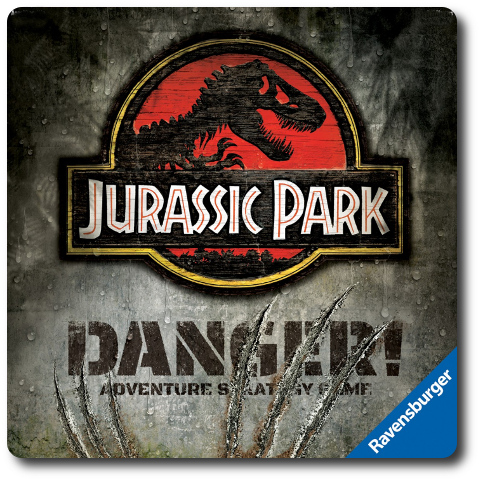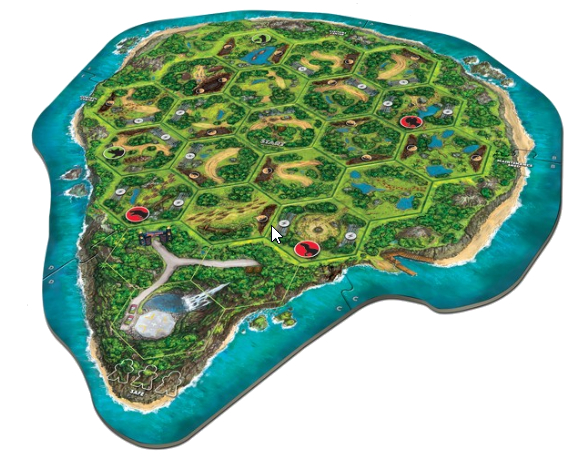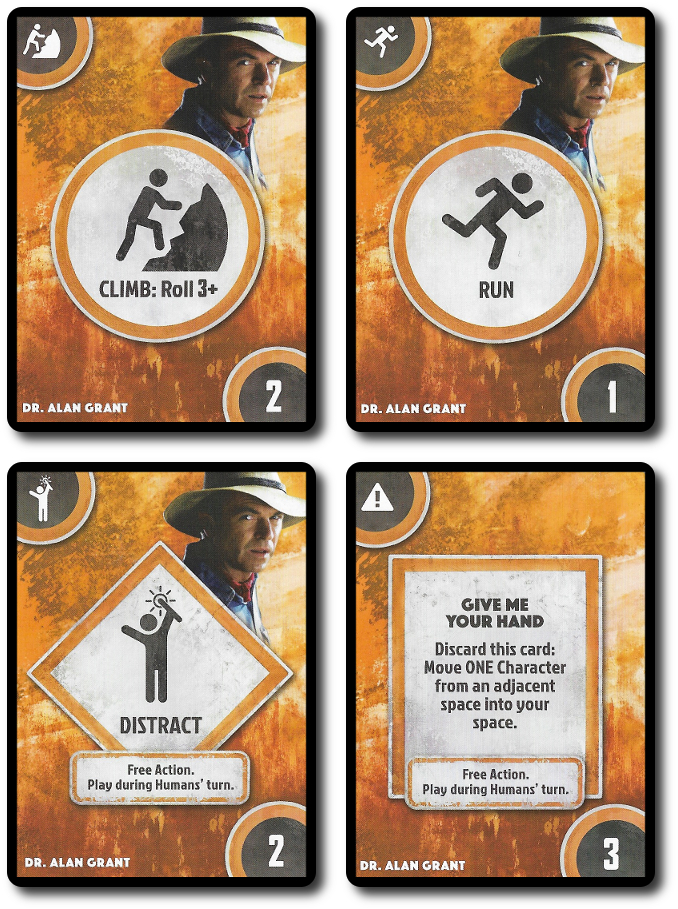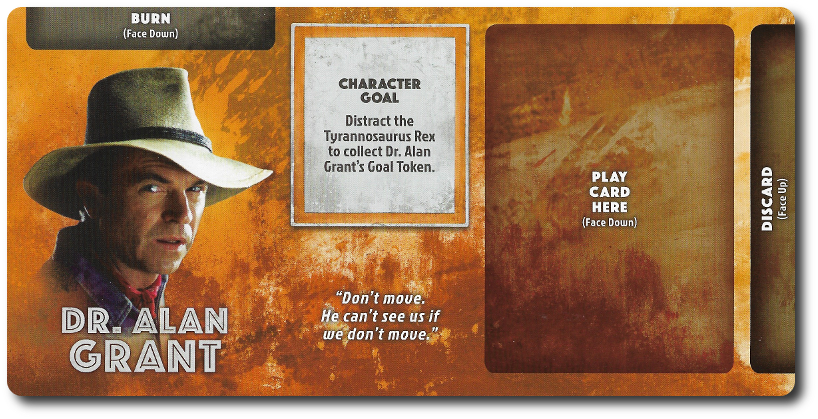
The Basics:
- For ages 8 and up (publisher suggests 10+)
- For 2 to 5 players
- Approximately 60 minutes to complete
Geek Skills:
- Active Listening & Communication
- Counting & Math
- Logical & Critical Decision Making
- Reading
- Strategy & Tactics
- Risk vs. Reward
- Cooperative & Team Play
- Hand/Resource Management
Learning Curve:
- Child – Easy
- Adult – Easy
Theme & Narrative:
- Survive!
Endorsements:
- Gamer Geek approved!
- Parent Geek approved!
- Child Geek approved!
Overview
American film director and screenwriter, Colin Trevorrow, said “There’s something about dinosaurs that should be very humbling to human beings.” Humankind has long been fascinated with these ancient lizards. We dig up their bones, dream of them, and yet are not frightened by their size and strength. Which makes sense because they are extinct. But what if they weren’t…?
Jurassic Park: Danger!, designed by Forrest-Pruzan Creative and published by Ravensburger, is comprised of 110 cards, 11 Player mats, 19 Island tiles, 5 Perimeter frames, 10 Character movers, 3 Dinosaur movers, 13 Fence tokens, 10 Goal tokens, 4 Lock tokens, 3 Location tokens, 1 Dinosaur Action token, 1 Helicopter token, and 1 standard six-sided die. The game component quality is excellent with thick boards, sturdy cards, and wooden meeples (of the traditional and dinosaur kind). Artwork is taken, in part, from the original Jurassic Park movie. They spared no expense.
Welcome to Jurassic Park!
To set up the game, first create the board game frame by connecting the Perimeter frame pieces together in the middle of the playing area. They snap in place like a puzzle piece and have letters on them to make it easier to connect.
Second, find and set aside the “Perimeter”, “Center”, and “Start” Island tiles. The names on the tiles are listed on the back of each tile, making this a super easy and fast exercise. Once these tiles are set aside, shuffle the “Perimeter” Island tiles and randomly place face-up in the open outside space within the Perimeter frame. Now shuffle the “Center” Island tiles and randomly place face-up in the open outside space within the Perimeter frame. Finally, take the “Start” Island tile and place face-up in the only open space within the Perimeter frame which also happens to be the island’s center. When completed, the game board will look similar to the following image.

Third, place the Lock, Fence, and Helicopter tokens to one side of the game playing area into piles to form the supply. Place the Maintenance Shed, Control Center, and Visitors Center tokens with their gray side face-up on the “Perimeter” Island tiles with the matching label. The labels are found on the Perimeter frame next to the tile.
Fourth, decide who will playing as the Dinosaurs and who will be playing as the Humans. For each Human player, give them a matching set of Human game components which includes one Character Player mat, one Character Goal token, one Character mover (i.e. a “meeple”), and ten Character cards. The Character player mat is placed in front of the owning player, face-up. Each player should read their Character Player card Character Goal out loud and then place their Character Goal token on the space noted in the goal description. Each player places their Character mover on the center “Start” Island tile at this time. Place any remaining Character pieces to one side of the game playing area.
Fifth, the player who is not taking on the role of a Human gets to be all the dinosaurs. Give to this player the Dinosaur Player mat, the Dinosaur cards, and Action token. The Dinosaur player shuffles their cards and draws three to create their starting hand (the Humans get all their cards as their starting hand), placing the remaining cards face-down in a draw pile next to their Dinosaur Player mat. Each Dinosaur mover has a starting position on the tiles which is indicated by a matching dinosaur icon. This includes the Velociraptor (clever girl!), Dilophosaurus (the one that spits), and the mighty Tyrannosaurus Rex (who needs no introduction).
That’s it for game set up. Let’s go visit the park!
Man Creates Dinosaurs…Dinosaurs Eat Man…
Jurassic Park: Danger! is played in rounds, steps, and turns. A typical game round is summarized here.
Step One: Dinosaur Player Selects Their Cards
The Dinosaur player has a hand of three cards. From these three cards they select one to play for the round. Once selected, it’s placed face-down on the Dinosaur Player mat space. Dinosaur cards indicate the action the Dinosaurs will be taking. For example, “Run” (move dinosaur to another Island tile), “Climb” (move dinosaur to another Island tile with cliffs and deactivated electric fences), and “Sneak” (a special move that is like “Run” and “Climb”, but the Dinosaur player reveals where their dinosaur moves later in the round, surprising the Human players).

Step Two: Human Players Select Their Cards
The Human players now select one card from their hand and place if face-down on their Human Player mat. Like the Dinosaur player, the Human player’s cards represent actions. “Run”, “Climb”, and “Sneak”, as well as “Distract” (force a Dinosaur to move towards a Human player). Each Human character also has a special card that is unique to their character. For example, Dr. Alan Grant can move any Human character on an adjacent tile to the same tile Dr. Alan Grant is currently on.

Step Three: Dinosaurs Take Their Turn
The Dinosaur player now reveals their card (unless they were forced to reveal their card early) and resolves it. The action noted on their player card is completed, with the addition of one extra optional special Dinosaur action.
Each special Dinosaur action is unique to one of the three main Dinosaurs the player controls. The Velociraptor can take additional movement, the Tyrannosaurus Rex can attack a Human player twice, and the Dilophosaurus can attack a Human character located on an adjacent Island tile. The optional Dinosaur action can target any Dinosaur the player has control over, not just the one they moved with their selected card. The only restriction is that the Dinosaur player cannot use the same Dinosaur action twice in a row. For example, the Dinosaur player could not have their Tyrannosaurus Rex attack twice in the current round and then again in the next round.
Finally, the Dinosaur player draws a new card to bring their hand size back up to three.
Step Four: Humans Take Their Turn
All Human players now reveal their selected cards simultaneously, resolving their cards and any free actions they might have in any order they like. Once resolved, the cards are placed in a discard pile (not burned). Players are never forced to complete their selected action, but they must discard the card if they don’t at least attempt it.
If a Human character is located on an Island tile with a Location token, they can attempt to activate it. Activating certain locations not only makes survival easier for the Human players, but also unlocks special benefits. For example, activating the Control Center gives the players the ability to lock down the island, making it more difficult for the dinosaurs to get around.
Taking Character actions and activating locations is done by rolling the die. A value on the card indicates what is needed to complete the action and activating locations requires a roll of five or more. For example, a “Sneak: Roll 3+” means the player must roll a three or more on the die or the action fails. Some Character cards have a “Boost Roll” value noted as a number on the lower right corner of the card’s face. After rolling the die, the player may “Burn” one or more cards in their hand to increase the rolled value by the Boost value shown. These cards are discarded in a special Burn discard pile. Cards that are burned are out of the game, so don’t go burning cards without thinking it through.
If the player successfully rolls (with or without a Boost value bonus), the action is completed. Failed rolls, like “Climb” and “Sneak”, means the action does not get completed, but the card played is not discarded. Instead, it’s brought back into the player’s hand.
Finally, each player, after resolving their turn, may decide to replenish their hand or not. If the player decides to replenish their hand, they “Burn” all remaining cards in their hand and replace them with any cards in their discard pile (not the Burn discard pile). But there is one additional catch. If a player ever runs out of cards, they have also run out of options. The good news here (if any) is that the player’s character is eliminated from the game, not the player. The player now draws a new Character and jumps into the game. The Dinosaur player keeps the Character meeple they took out (read: ate) as a trophy, which also means that the specific Character is no longer playable…because they were eaten.
This ends the round. A new round now begins with step one noted above.
After Careful Consideration, I’ve Decided Not to Endorse Your Park
The game can end one of two different ways.
The Human players win if a certain number survive and leave the island. Human players leave by activating certain locations and then jumping on the helicopter. One a player saves a character, they take a new one (if any are still available) and continue playing. But before a character can jump on the helicopter, they must complete their Character Goal. For example, Dr. Alan Grant cannot escape the island until he distracts the mighty Tyrannosaurus Rex, which just seems unnecessarily dangerous.

The Dinosaur player wins by eliminating the Human characters through dinosaur attacks and by forcing them to use all their cards. Dinosaur attacks “eat” player cards, which reduces a player’s effectiveness. If at any time the dinosaurs eliminate three Human characters, they rule the island and win.
To learn more about Jurassic Park: Danger!, visit the game’s web page.
Final Word
 The Child Geeks had a lot of fun and most were disappointed that they couldn’t play as the dinosaurs. According to one Child Geek, “I like the game a lot but wish I could always play as the dinosaurs. They are a lot of fun.” The dinosaurs are fun to play, but only one player per game gets to enjoy the thrill of hunting down mathematicians, paleontologists, and amusement park entrepreneur. This was, not surprisingly, disliked by the kiddos. Another Child Geek said, “The game feels like you have to work together, but sometimes you don’t have to or want to.” The game does slip from cooperative to semi-cooperative many times. You don’t need everyone to win, but at the same time, players cannot possibly win the game alone. Well, the dinosaur player can, but that’s a different matter. When all the players were either eaten, flown off the island, or had their fill of humans, they voted to approve the game.
The Child Geeks had a lot of fun and most were disappointed that they couldn’t play as the dinosaurs. According to one Child Geek, “I like the game a lot but wish I could always play as the dinosaurs. They are a lot of fun.” The dinosaurs are fun to play, but only one player per game gets to enjoy the thrill of hunting down mathematicians, paleontologists, and amusement park entrepreneur. This was, not surprisingly, disliked by the kiddos. Another Child Geek said, “The game feels like you have to work together, but sometimes you don’t have to or want to.” The game does slip from cooperative to semi-cooperative many times. You don’t need everyone to win, but at the same time, players cannot possibly win the game alone. Well, the dinosaur player can, but that’s a different matter. When all the players were either eaten, flown off the island, or had their fill of humans, they voted to approve the game.
 The Parent Geeks also enjoyed the game, and like the Child Geeks, always wanted to play as the dinosaurs. As one Parent Geek put it, “I really liked the first movie and the book and strangely hoped the dinosaurs would win. I still am.” The Parent Geeks found Jurassic Park: Danger! to be just as entertaining with their family and they did with their friends. According to one Parent Geek, “The great thing about cooperative games is that I can play it with my younger kids and help them out without playing the game for them. They learn how to work as a team.” Very true and in this game, team work is essential for survival, both as a human and as a dinosaur. When the games were over and everyone had a chance to play as the dinosaurs, the Parent Geeks voted to approve the game.
The Parent Geeks also enjoyed the game, and like the Child Geeks, always wanted to play as the dinosaurs. As one Parent Geek put it, “I really liked the first movie and the book and strangely hoped the dinosaurs would win. I still am.” The Parent Geeks found Jurassic Park: Danger! to be just as entertaining with their family and they did with their friends. According to one Parent Geek, “The great thing about cooperative games is that I can play it with my younger kids and help them out without playing the game for them. They learn how to work as a team.” Very true and in this game, team work is essential for survival, both as a human and as a dinosaur. When the games were over and everyone had a chance to play as the dinosaurs, the Parent Geeks voted to approve the game.
 The Gamer Geeks were pretty funny. When they were playing as the Human characters, they fought each other. Even going so far as to tell a peer that they were “doing it wrong”. All the Gamer Geeks understood that each of them had their own goal, as well as the universal goal of getting off the island alive. They also understood that each team member was somewhat expendable. According to one Gamer Geek, “You need the help of the others, but only until you get on that helipad. After that, so long, suckers!” The only Gamer Geeks who were ever quiet when playing were those who were taking on the role of the dinosaurs. One such Gamer Geek told me, “It is so much fun watching the other players run around the island while I secretly plot to eat them all and chew away at their team resolve.” Nice pun. All the Gamer Geeks voted to approve Jurassic Park: Danger!, finding it to be a game that tested their patience (in a good way) and challenged them to think creatively.
The Gamer Geeks were pretty funny. When they were playing as the Human characters, they fought each other. Even going so far as to tell a peer that they were “doing it wrong”. All the Gamer Geeks understood that each of them had their own goal, as well as the universal goal of getting off the island alive. They also understood that each team member was somewhat expendable. According to one Gamer Geek, “You need the help of the others, but only until you get on that helipad. After that, so long, suckers!” The only Gamer Geeks who were ever quiet when playing were those who were taking on the role of the dinosaurs. One such Gamer Geek told me, “It is so much fun watching the other players run around the island while I secretly plot to eat them all and chew away at their team resolve.” Nice pun. All the Gamer Geeks voted to approve Jurassic Park: Danger!, finding it to be a game that tested their patience (in a good way) and challenged them to think creatively.
 There’s a lot about this game that I enjoyed that took the traditional cooperative game off the rails. Each player (except for the player controlling the dinosaurs) is working together…kind of. Everyone has the same goal to get off the island and survive, but it isn’t that simple. To begin with, not everyone has to get off the island to win. This means the supposed team members to the left and right of you are nice to have around, but not necessary for victory. Second, each player has a specific Character Goal they must achieve before they can even attempt to get off the island. This means that every Human character in the game comes with baggage. As the game progresses and the dinosaurs are eating everyone up, players tend to look at the game as more semi-cooperative than cooperative.
There’s a lot about this game that I enjoyed that took the traditional cooperative game off the rails. Each player (except for the player controlling the dinosaurs) is working together…kind of. Everyone has the same goal to get off the island and survive, but it isn’t that simple. To begin with, not everyone has to get off the island to win. This means the supposed team members to the left and right of you are nice to have around, but not necessary for victory. Second, each player has a specific Character Goal they must achieve before they can even attempt to get off the island. This means that every Human character in the game comes with baggage. As the game progresses and the dinosaurs are eating everyone up, players tend to look at the game as more semi-cooperative than cooperative.
Which brings me to the dinos. If you are playing the game as the recently extinct giant lizards, you are playing an entirely different game than the others around you. As different locations around the island are brought back online, the game becomes harder to play. It’s in the Dinosaur player’s best interest to keep that from happening as working electric fences restricts movement, locked doors restricts entire Island tiles, some locations give Human characters their cards back, and of course, there is the helicopter that allows everyone to escape.
I very much enjoyed my time with Jurassic Park: Danger! It plays fast, feels exciting, and kept me interested from start to finish. The game plays differently based on which side you are on, but regardless of which team you are rooting for, it’s a challenge. Humans don’t have it any easier than the dinosaurs. The game feels very balanced and, best of all, empowers the players to make choices that make sense to them in hope of achieving their objectives. Do try Jurassic Park: Danger! when time allows. To quote the movie character, John Hammond, “How can we sit in the light of discovery and not act?” Go forth and game!
This game was given to Father Geek as a review copy. Father Geek was not paid, bribed, wined, dined, or threatened in vain hopes of influencing this review. Such is the statuesque and legendary integrity of Father Geek.



